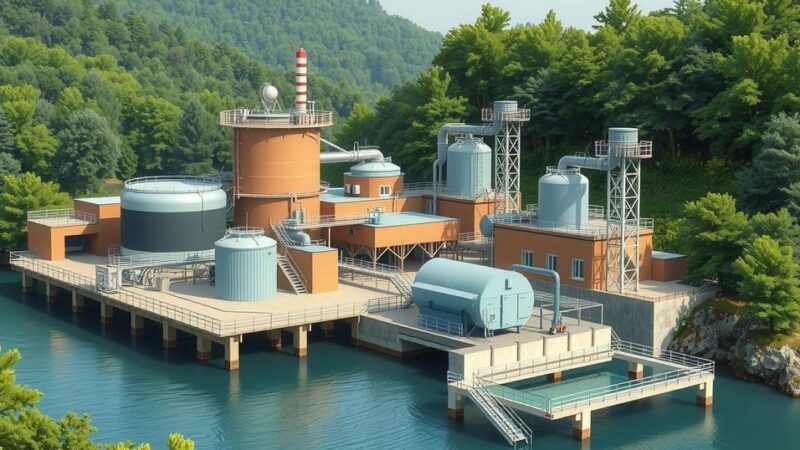Pakistan has been ranked the third most polluted country in 2024 amid a record smog season, with PM2.5 levels nearly 15 times above WHO’s safe limit. The report by IQAir identified Chad and Bangladesh as the top two polluted countries. Health concerns are significant, with many citizens suffering from pollution-related ailments. Pakistan’s pollution sources include industrial activities and vehicle emissions, and while some cities improved, major challenges remain in combating air quality issues.
In an annual report released by Swiss air technology company IQAir, Pakistan has been ranked as the third most polluted country in 2024, primarily due to an unprecedented record smog season. Chad has secured the top position for air pollution, followed by Bangladesh, Pakistan, the Democratic Republic of Congo, and India. Pakistan has faced alarming smog levels particularly in Punjab, necessitating governmental intervention such as lockdowns and school closures to mitigate the crisis.
The report states that the average concentration of particulate matter measuring less than 2.5 microns (PM2.5) in Pakistan was recorded at 73.7 micrograms per cubic meter, which is nearly 15 times the safe limit set by the World Health Organization (WHO). Despite experiencing record smog levels, the average pollution readings for Pakistan remained unchanged compared to 2023. Within Central and South Asia, Pakistan ranked second, with cities like Lahore, Multan, Peshawar, and Sialkot noted among the region’s 15 most polluted locales.
Various sources contributed to Pakistan’s continuous high pollution levels, including biomass burning, industrial activities, vehicle emissions, brick kilns, and construction dust, as highlighted in the report. From 2023 to 2024, cities such as Peshawar, Islamabad, Rawalpindi, and Lahore noted substantial increases in their annual average levels, while Faisalabad exhibited only a minor rise. Interestingly, Karachi’s PM2.5 levels improved, decreasing from over 55 micrograms per cubic meter in 2023 to approximately 46 micrograms per cubic meter in 2024.
Five Pakistani cities recorded PM2.5 levels exceeding 200 microns during November, posing significant health risks. An Ipsos report indicated that about 70% of the population in Pakistan experienced health issues due to smog. In comparison, Chad’s pollution levels were found to be 18 times higher than WHO’s safe thresholds, while India’s levels were ten times above the recommended limits. Despite a slight improvement, India still housed six of the world’s nine most polluted cities in 2024.
The report identified Byrnihat, an industrial town along the Meghalaya-Assam border, as the most polluted metropolitan area globally, with an alarming average of 128.2 micrograms per cubic meter of PM2.5. New Delhi retained the title of the most polluted capital, closely followed by N’Djamena in Chad. The figures detailed in the report indicate that Indian cities suffer extensively from hazardous concentrations stemming from vehicles, agricultural burning, and industrial waste, evidenced by Baddi’s harsh winter average of 165 microns in January, well above WHO’s guidelines.
In stark contrast, the report highlighted that Oceania was the cleanest region globally, with 57% of cities meeting the WHO’s PM2.5 annual guideline values. Bosnia emerged as Europe’s most polluted country, with PM2.5 readings significantly over the WHO threshold, followed by North Macedonia and Serbia. Unfortunately, insufficient data meant that Burkina Faso, Iran, and Afghanistan could not be included in the analysis. Of the countries assessed, only seven managed to achieve readings beneath WHO guidelines: Estonia, Iceland, Australia, New Zealand, the Bahamas, Grenada, and Barbados. The increased percentage of cities meeting the WHO standards—17% in 2024 compared to 9% in 2023—brings a degree of hope, despite the ongoing global air pollution crisis.
The 2024 IQAir report has underscored the alarming air pollution levels in Pakistan, ranking it as the third most polluted country in the world alongside dire conditions across South Asia. The persistent issues stemming from various environmental sources have produced significant health implications, with an overwhelming majority of the population experiencing related health problems. While there were minor improvements in specific cities, substantial challenges remain in addressing the overarching pollution crisis effectively. The report highlights the necessity for ongoing governmental measures and collective action to ameliorate air quality, not only in Pakistan but also regionally and globally.
Original Source: www.dawn.com






